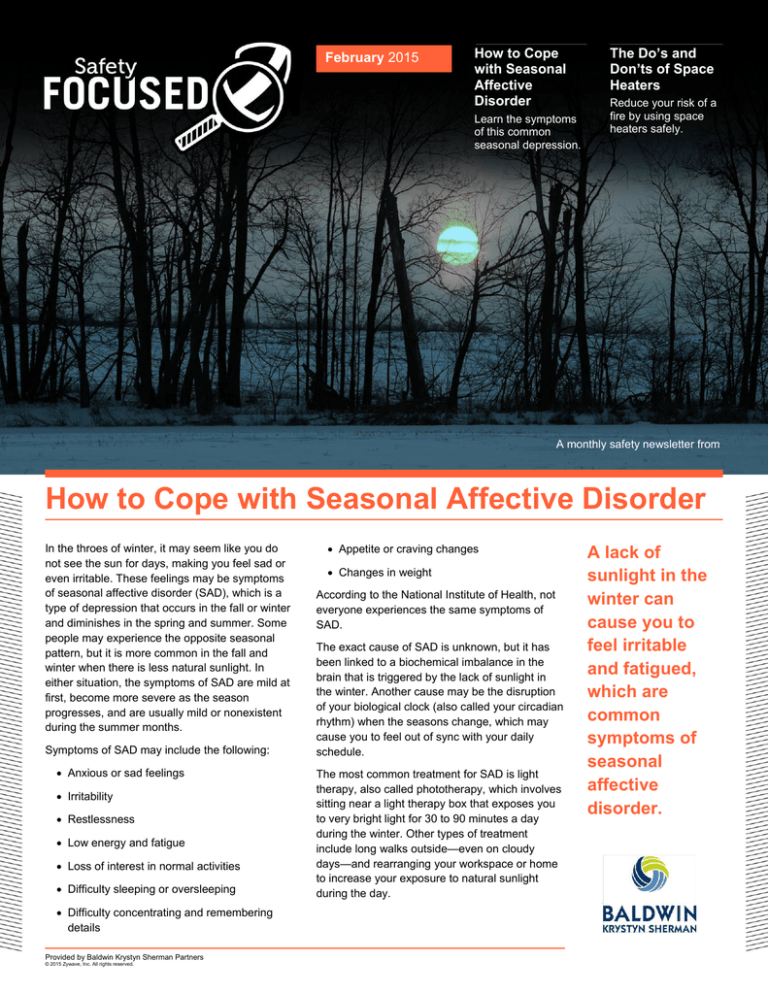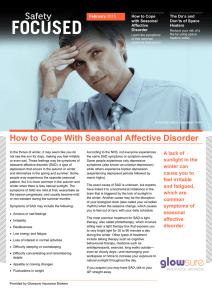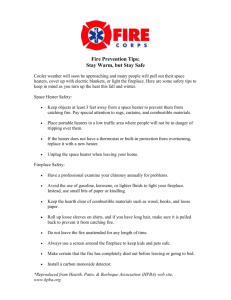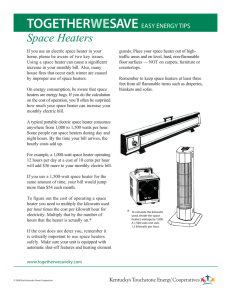
February 2015
How to Cope
with Seasonal
Affective
Disorder
Learn the symptoms
of this common
seasonal depression.
The Do’s and
Don’ts of Space
Heaters
Reduce your risk of a
fire by using space
heaters safely.
A monthly safety newsletter from
How to Cope with Seasonal Affective Disorder
In the throes of winter, it may seem like you do
not see the sun for days, making you feel sad or
even irritable. These feelings may be symptoms
of seasonal affective disorder (SAD), which is a
type of depression that occurs in the fall or winter
and diminishes in the spring and summer. Some
people may experience the opposite seasonal
pattern, but it is more common in the fall and
winter when there is less natural sunlight. In
either situation, the symptoms of SAD are mild at
first, become more severe as the season
progresses, and are usually mild or nonexistent
during the summer months.
Symptoms of SAD may include the following:
Anxious or sad feelings
Irritability
Restlessness
Low energy and fatigue
Loss of interest in normal activities
Difficulty sleeping or oversleeping
Difficulty concentrating and remembering
details
Provided by Baldwin Krystyn Sherman Partners
© 2015 Zywave, Inc. All rights reserved.
Appetite or craving changes
Changes in weight
According to the National Institute of Health, not
everyone experiences the same symptoms of
SAD.
The exact cause of SAD is unknown, but it has
been linked to a biochemical imbalance in the
brain that is triggered by the lack of sunlight in
the winter. Another cause may be the disruption
of your biological clock (also called your circadian
rhythm) when the seasons change, which may
cause you to feel out of sync with your daily
schedule.
The most common treatment for SAD is light
therapy, also called phototherapy, which involves
sitting near a light therapy box that exposes you
to very bright light for 30 to 90 minutes a day
during the winter. Other types of treatment
include long walks outside—even on cloudy
days—and rearranging your workspace or home
to increase your exposure to natural sunlight
during the day.
A lack of
sunlight in the
winter can
cause you to
feel irritable
and fatigued,
which are
common
symptoms of
seasonal
affective
disorder.
The Do’s and Don’ts of Space Heaters
Sometimes you cannot escape the cold, even in
your home. You may turn to supplemental
heating equipment such as a portable space
heater for additional warmth. However, space
heaters can be dangerous. According to the
National Fire Protection Association, a third of
home heating fires are caused by space heaters.
Follow these do’s and don’ts to use your space
heater safely and reduce your fire risk.
Do:
Keep any flammable items at least 3 feet
from space heaters. This includes clothing,
drapes, upholstered furniture and bedding.
Turn off space heaters when you leave the
room or go to sleep.
Supervise children and pets around space
heaters to prevent burns.
Purchase a space heater with the
Underwriters Laboratories (UL) safety mark,
which signifies that the product was tested
for potential safety hazards. Also look for
units with automatic shut-off features and
heating element guards.
Keep space heaters away from water.
Place space heaters on hard, level surfaces
away from walking areas.
Don’t:
Use space heaters to warm bedding, thaw
pipes or dry clothing. Misusing a space
heater can increase fire and burn risks.
Use a space heater that has frayed
insulation, broken wires or signs of
overheating. If you notice any of these
problems, have the unit serviced
immediately.
Plug a heater in using an extension cord. If
you must do so, make sure that the cord is
the right gauge size and type for the heater.
Use a heater near a sink or in the bathroom.
Space heaters are meant for temporary use and
should not be used for extended periods, such as
overnight. Every year people lose their homes to
fires started by dangerous space heater use—
don’t let it happen to you.
Space Heaters Need Space
An unusually cold night in Alabama prompted a
man to retrieve a space heater from his garage to
use for added warmth while he read a book in his
living room. The man stationed the space heater
two feet away from his chair and wrapped himself
in a blanket before relaxing with his book.
After an hour of reading, the man went into the
kitchen, left the blanket on the chair and did not
turn off the space heater. The edge of the blanket
was only inches away from the heater, which
caused it to catch on fire and quickly spread from
the blanket to the upholstered chair. The man ran
outside and called the fire department, which
arrived quickly and was able to extinguish the fire
that had almost engulfed the man’s living room.
Thankfully, the fire was confined to the chair and
did not cause extensive damage to his home.
If the man had turned off the heater when he left
the room and made sure it was at least 3 feet
away from the blanket and upholstered chair, he
could have avoided this dangerous situation.
Source: National Fire Protection Association





